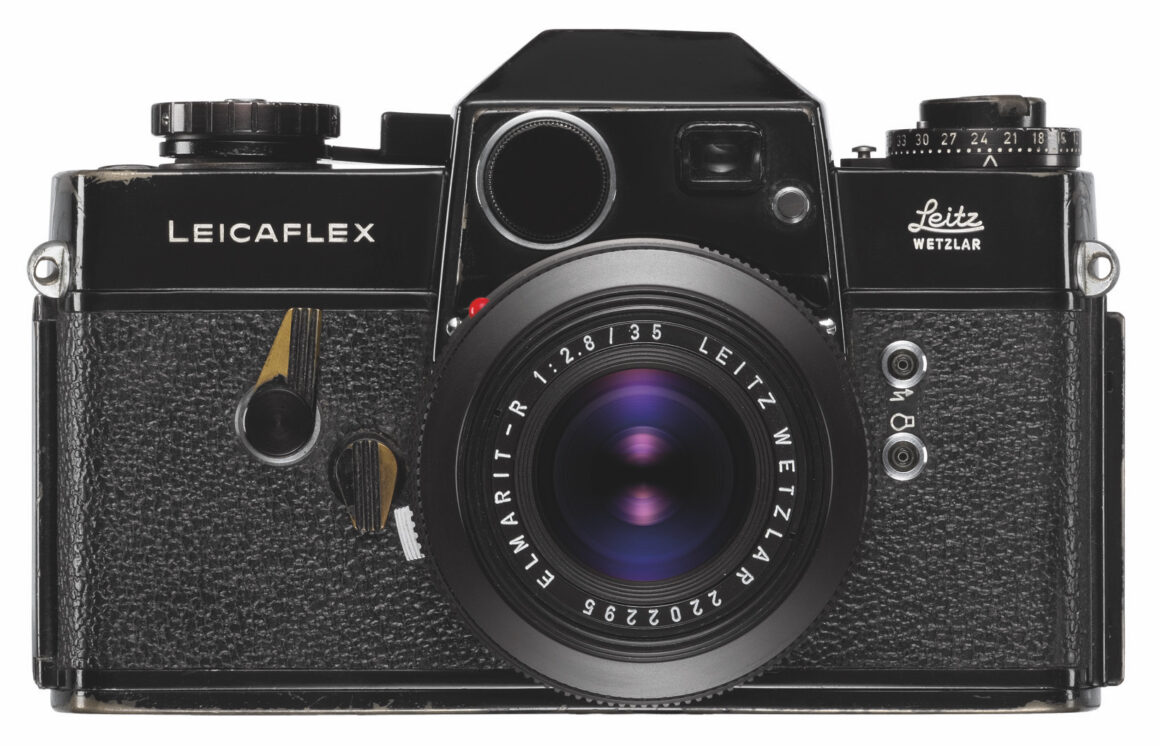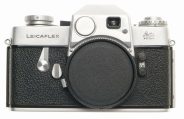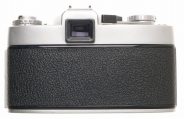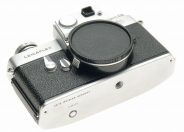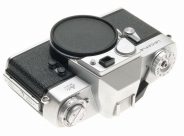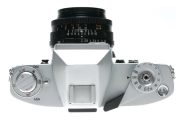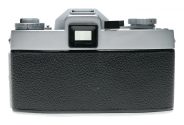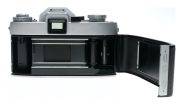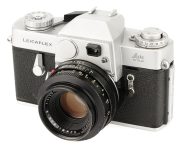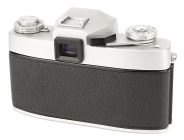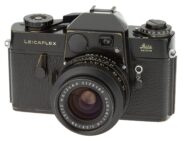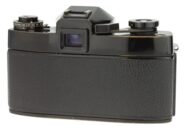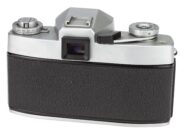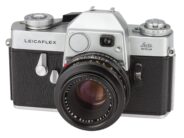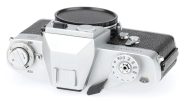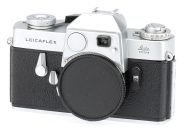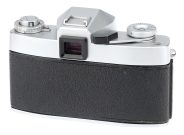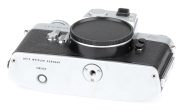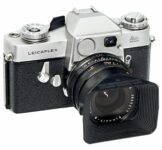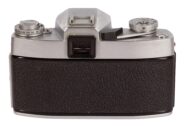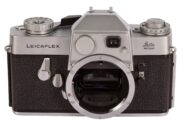Leicaflex
35mm MF film SLR camera
Specification
| Production details: | |
| Announced: | 1964 |
| Order No.: | 10001 - body without lens |
| 10218 - body with SUMMICRON-R 50/2 | |
| System: | ● Leica R (1964) |
| Format: | |
| Maximum format: | 35mm full frame |
| Film type: | 135 cartridge-loaded film |
| Mount and Flange focal distance: | Leica R [47mm] |
| Shutter: | |
| Type: | Focal-plane |
| Model: | Mechanical |
| Speeds: | 1 - 1/2000 + B |
| Exposure: | |
| Exposure metering: | Through the separate window |
| Exposure modes: | Manual |
| Physical characteristics: | |
| Weight: | 770g |
| Dimensions: | 148x97x57mm |
| Accessories: | |
| Body cap: | 14103 |
Manufacturer description #1
From the LEICA photography magazine (1965, No. 1):
Offering traditional Leitz precision and ease of operation, the new Leicaflex is a no-nonsense camera which brings Leica quality, ruggedness and reliability to the 35mm single-lens reflex field. Built for results, the Leicaflex is the cornerstone of a new Leitz reflex camera system that will be developed to parallel (but not replace) the Leica-M range-viewfinder system from which it has inherited many of its sturdily dependable ways.
The Leicaflex is manufactured to tight, Leica-standard tolerances. It features a new family of auto-aperture lenses, a new instant-return mirror mechanism, new extra-bright viewfinder optics, a new built-in cadmium sulphide exposure meter, and a new focal-plane shutter that stops action cold at 1/2000 sec. and synchronizes with electronic flash a t 1/100th sec. And, it is quiet!
One of the first things that you'll notice about the Leicaflex (once having become acquainted with its bright focusing screen and smooth, precise mechanical functions) is its quietness. There's none of the usual reflex crash-bang.
human engineering
Designed by engineers who are also active photographers, for active photographers who are not engineers, the Leicaflex presents a comfortable handful of readily accessible, logically located, easy-to-operate controls with big, legible markings. Film-transport, shutter-release and speed selection are grouped together in a single coaxial assembly at the right-hand side of the top deck. The single-stroke advance lever snaps out to a comfortable ready position, well clear of the viewfinder eyepiece to permit left-eye use. Your right-hand thumb and forefinger fall naturally over these controls while your left hand engages the lens. Whichever eye you put to the extra-large eyepiece lens (it gives even eyeglass wearers a comfortable view of the whole field), the Leicaflex "fits" like a pair of well-worn gloves.
Speaking of gloves, the Leicaflex auto-aperture lenses can be manipulated while wearing them, if need be. All have the auto-aperture preselector ring at the base, right next to the camera body. And, in all cases, the focusing ring is at the front where you can grab it without worrying about upsetting the exposure. Learn to handle any one of these anodized beauties, and you've learned to handle all of them. The large, non-rotating speed selector dial has firm click-stops for speeds from 1 to 1/2000th sec., plus Bulb. A speed scale is also visible through the viewfinder, just underneath the picture-field. This lets you change speeds in mid-picture, so to speak, without taking your eye from the finder.
This feature also speeds up operation of the built-in exposure meter that lets you set the correct exposure as soon as the Leicaflex reaches its eye-level operating position.
focusing and viewing
The instant-return mirror and auto-aperture lenses keep the picture before your eye except for the instant of exposure. There's no visible mirror black-out, or aperture dim-out with the Leicaflex except at the instant of exposure. Computed in relation to the specially developed reflex-focusing Leicaflex lenses, the finder system works with all lenses at full aperture to provide maximum brightness.
A circular patch containing more than 13,000 tiny micro-prisms is centered in the unusually bright viewing screen. These precision surfaces make focusing fast and easy by deflecting out-of-focus light rays to exaggerate the visual difference between correctly and incorrectly focused objects. The prismatic effect is so pronounced that a second contour is found around the edges of out-of-focus objects, and a watery pattern is seen until the lens is in focus. When the center spot is clear, the image is sharp.
Fast, accurate focusing is enhanced by the camera's high screen-brilliance and the telescope power, or viewfinder magnification, of the system. This depends on the focal length of the lens being used and is almost 1:1 with the standard 50mm Summicron-R f/2 lens. Here are the finder magnifications provided by the four introductory Leicaflex lenses:
Focal Length - Finder Magnification
35mm - 0.6X
50mm - 0.9X
90mm - 1.5X
135mm - 2.3X
In addition to giving a parallax-free image with all lenses, and at all distances, the Leicaflex viewing screen is precision-adjusted in relation to the film-gate. The viewing screen shows a 23 x 35mm image (in accordance with the international standard for color film slide mounts), while the actual film dimensions are 1/2 mm more in all four directions. Viewfinder center and picture center correspond exactly.
steady as she goes!
The loss of image sharpness through mirror vibration, one of the most-discussed SLR bugaboos, has been virtually eliminated by the Leitz-patented mirror mechanism of the Leicaflex. In fact, tests made with a high-power microscope prove conclusively that the vibration of the Leicaflex mirror is only negligibly more than vibration in the Leica-M camera. And, since the Leica-M shutter is famous for its unbeatable smoothness, this took some doing!
This has been achieved by a system of levers which starts the mirror from a dead-point, accelerates it to a maximum swinging speed in the center of its motion, and then brings it to a second dead-point stop without banging into the top-plate of the camera housing.
Another interesting aspect of this design is that the auto-aperture actuator arm is connected directly to the mirror-raising mechanism; both derive their energy from the same springs. This guarantees that the Leieaflex lens is always fully closed down to the preselected aperture before the shutter can begin to travel. By linking the two preliminary functions of mirror-raising and aperture-closing together, an often-overlooked source of SLR vibration has been eliminated in the Leieaflex. The action of the Leicaflex mirror, auto-aperture, and shutter-braking mechanisms eliminates any appreciable camera vibration, permitting confident use of even the slowest shutter speeds.
In photomicrography and high-magnification macro photography, however, all vibration, no matter how insignificant, is magnified in direct proportion to the image magnification. For these special applications, the Leieaflex has a mirror-control lever which permits the mirror to be raised separately, before the shutter is released.
fast, quiet, and efficient
The Leicaflex focal-plane shutter is a new design. Its increased curtain velocity permits a top speed of 1/2000th sec., and (even more important) the shutter synchronizes electronic-flash units at 1/100th sec. Automatic compensation for acceleration is provided by a Leica-type design in which the moving slit widens itself as it crosses the film gate. This ensures uniform exposures over the whole film area, even at the top speed of 1/2000th sec. The higher curtain velocity also increases the camera's optical efficiency since the moving slits for speeds are proportionately wider. Speeds are arranged in geometrically doubling progression from 1 to 1/2000th sec., plus Bulb. Firm click-stops are provided at each marked speed. As previously mentioned, the speed setting is also visible through the viewfinder, on a scale appearing directly underneath the picture-field. Intermediate exposure times can be set over the full range, when desired, except between 1/8th and 1/4th sec.
Two separate flash circuits, each with its own standard P-C polarized, marked contact, are provided for speedlight units as well as conventional flash-bulbs. Electronic-flash synchronization is available up to 1/100th sec., this setting being indicated by a lightning-bolt on the speed selector dial. Standard medium-peak (Class M) lamps can be synchronized at all speeds. Guide-numbers, however, become unprofitably low at speeds in excess of 1/250th sec., so most photographers prefer a setting of 1/125th sec. Small zirconium-filled flash lamps of the AG-1 type must be synchronized at speeds no higher than 1/60th sec. because of their different ignition characteristics. Flash-wise, the Leicaflex is ready to go with anything that glows!
easy loading
The design of the Leicaflex body, since it is deep and rugged enough to house the prism-and-mirror system, permits the use of a hinged back which swings wide open. This offers easy loading and a quick, positive, visual check that all is in order before locking up to begin shooting. Once the film leader has been pushed into any of three slots, equally spaced on the core of the permanently mounted take-up spool, you are ready to close the camera and crank the first frame into place. And when you've finished the last exposure, a built-in rewind crank stands ready to whisk the film back into its cartridge for a quick change to a new roll.
sensitive, accurate, and handy
The built-in Leicaflex exposure meter utilizes a battery-powered cadmium-sulphide photoresistor cell. The battery is the button-sized PX-625 (with white ring). Its useful life is between one and two years and it is recommended for use in the Leicaflex even at well-below-freezing temperatures - to 14°F. to be precise. Film-speed indexes are provided from ASA 8 to an optimistic 6,500 on a dial which is coupled to the meter's follower arm. A locking button positively preents accidental upsetting of the speed index, eliminating one of the most troublesome problems of exposure-metermanship. The meter's sensitivity ranges from approximately 0.2 to 1500 candles-per-square-foot, or from weak reading illumination to blinding equatorial sunlight.
When you look through the Leicaflex finder you see the meter needle and a circle-topped follower-arm at the right-hand side of the viewing screen. Match the needles and you've set the correct exposure. Since the meter follower-arm is cross-coupled with the shutter-speed selector dial and the auto-aperture rings of all the Leicaflex lenses, either can be turned to adjust the exposure. In practice, however, it is probably preferable to start by setting the shutter speed, then obtain the correct exposure by turning the auto-aperture ring until the follower-arm circle surrounds the tip of the meter needle.
If your shutter speed is too high or too low for the anticipated subject motion, the speed scale in the finder lets you change this without taking the camera from your eye. Two circles engraved on the focusing screen, a large one in the upper-right-hand corner, and a small one below at the right-hand corner, let you know if you're opening-up or closing-down the lens. When the follower-arm moves toward the large circle, the aperture is increasing, and vice-versa. My own method for "reading" the aperture without taking my eye from the Leicaflex finder is quite simple.
It takes only a few seconds to turn the auto-aperture ring of the lens all the way to the right (thus opening the lens to full aperture) and then to count the clicks as you come down the scale to match the meter needles. Since all auto-aperture Leicaflex lenses work in exactly the same way, all you have to remember is that each click is worth exactly half an f/stop.
The rectangular measuring field of the Leicaflex meter corresponds to the field of the 90mm lens. Because of the relatively narrow 27° acceptance angle, the meter gives accurate exposures when the most important part of the subject is covered by the focusing spot in the center of the Leicaflex viewing screen.
The meter's measuring field, when used with a 35mm lens, is a small rectangle just surrounding the focusing circle. With the 50mm lens, the field is a rectangle occupying about half the finder field, with the same center. The meter's field is about 50% larger than that produced by the 135mm lens.
The beauty of this precise, built-in CdS meter is that it's cross-coupled in such a way that it in no way interferes with, or changes, normal camera-handling. When you want it, it's there. You can line the needles up in less time than it took to read this sentence. When you don't need its advice, go your way: All shutter-speeds and lens-apertures can be used regardless of the film-speed index set into the meter.
More than this, it's one of the most accurate and dependable meters, and one that's always right there in front of you every time you take a picture. With its pointers permanently imaged inside the finder field, the meter keeps you aware of lighting changes as they occur. You need never take your eye from the finder to make the necessary adjustment.
The Leicaflex checks out as a very regal reflex camera - smooth and fast-handling, with a quiet, practically vibration-free mirror/shutter action and the brightest viewfinder of any. After all, it's the only 35mm single-lens reflex camera that's made to the standards of a Leica. Need I say more?
Manufacturer description #2
From the LEICA photography magazine (1965, No. 3):
Queen Elizabeth II of England, who shares an enjoyment of photography with her husband, sister and brother-in-law, is now the owner of a unique Leicaflex. During her recent visit to Germany, she was presented with the camera and accessory lenses by Dr. Georg August Zinn, minister of the province of Hessen.
The camera and handsome carrying case are both adorned with a crown and the royal initials "E. II R." Queen Elizabeth also owns a similarly engraved Leica M3.
Manufacturer description #3
Single-lens-reflex camera, focusing screen with microprism measuring field, built-in CdS exposure meter, lens bayonet mount, focal plane shutter 1 to 1/2000 sec. and B, electronic flash 1/100 sec., automatic frame counter under magnifier.
Serial No. from 1080114.
Manufacturer description #4
The LEICAFLEX is a solid, fast-handling SLR built for results plus reliability by the people who made 35mm photography famous. Manufactured to traditional LEICA standards of optical and mechanical excellence, this is the precision reflex that critical photographers have long demanded.
The wonderful world of reflex photography is imaged through the LEICAFLEX viewfinder with unbelievable brilliance and clarity. New too are the high-speed focal-plane shutter and the vibration-free instant-return mirror that comes to a gentle stop before the shutter can begin to move. This is only one of the hidden features that ensure top optical performance from the auto-aperture LEICAFLEX lenses. These newly designed optics, computed especially for reflex photography, bring LEICA definition and crispness to the reflex camera field.
Matched picture-taking and viewfinder optics of advanced LEITZ design bring new reflex brilliance and clarity. Precision micro-prisms make focusing fast, accurate, and easy - ensure top performance from superbly corrected new LEICAFLEX lenses. Instant-return mirror and automatic lens apertures eliminate mirror black-out, aperture dim-down.The ultra-bright finder image is always there, except for the very brief interval of exposure.
New high-speed focal-plane shutter freezes action at 1/2000 sec, synchronizes electronic-flash at 1/100 sec.
The shutter speed selector dial, release button, and single-stroke advance lever are united in a control cluster. No need to take your eye from the finder for a speed change: a second scale, just below the picture field, always shows your shooting speed.
Forget about the narrow latitude of color films: this highly accurate battery-powered CdS meter is always on the job, its needle and follow-pointer ever-present in the LEICAFLEX viewing screen. Cross-coupled for maximum convenience, the meter permits exposure setting with full freedom to adjust either shutter speed or lens aperture. Wide-range meter sensitivity extends from 0.2 to 1,500 candles/ft2.
From the editor
The first Leica SLR camera. Lenses for LEICAFLEX had single cam giving automatic diaphragm coupling so that focusing was at full aperture.
